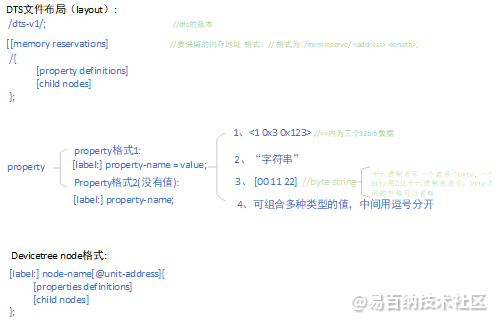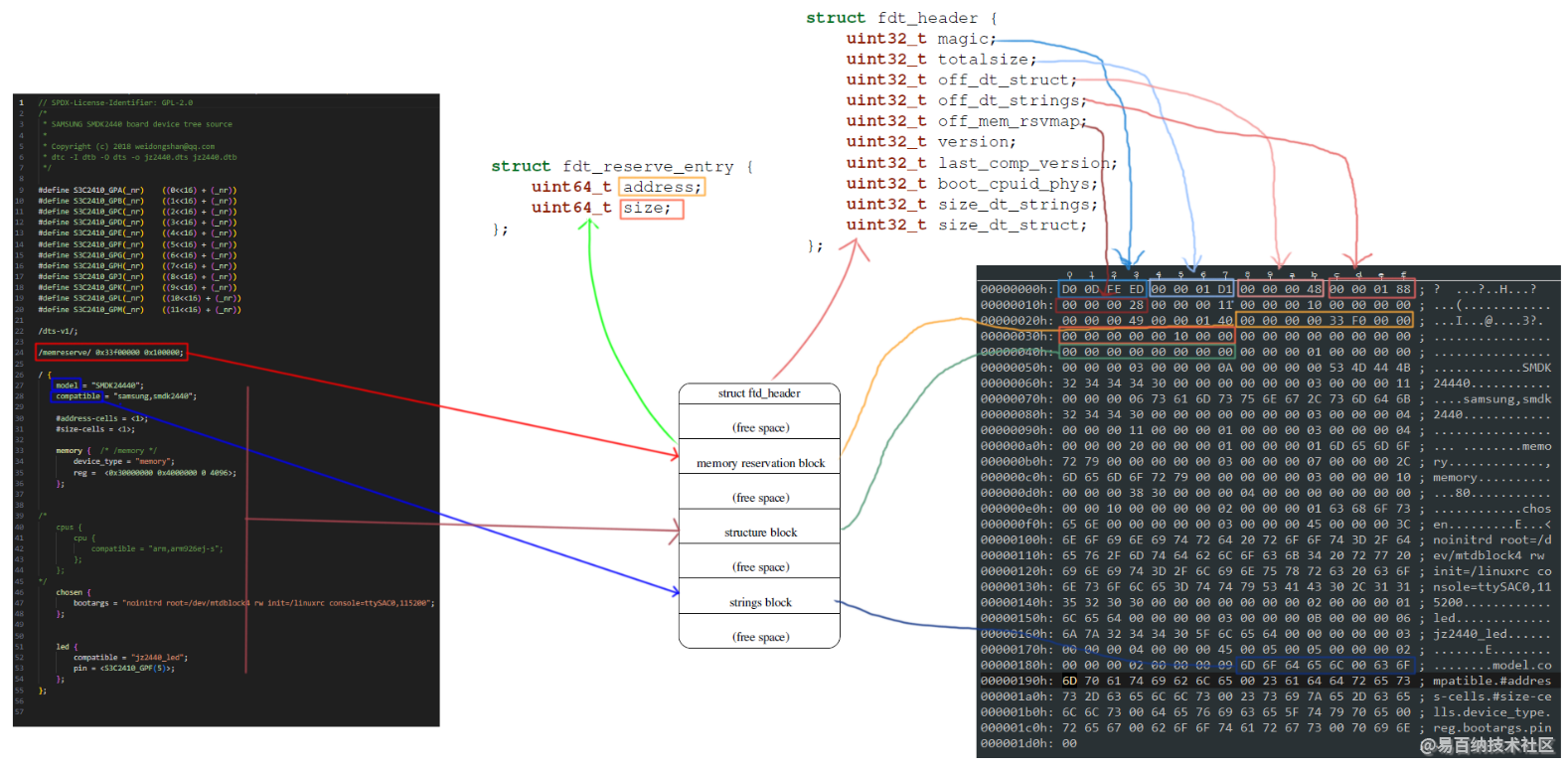设备树 DTS 格式--设备树的规范(dts和dtb)
设备树 DTS 格式—设备树的规范(dts和dtb)
DTS 格式
语法
Devicetree node格式:
[label:] node-name[@unit-address] {
[properties definitions]
[child nodes]
};
Property格式
1. 格式1
[label:] property-name = value;
2. 格式2(没有值)
[label:] property-name;
Property取值(3种方式)
- arrays of cells(1个或多个32位数据, 64位数据使用2个32位数据表示),
- string(字符串),
- bytestring(1个或多个字节)
示例:
a. Arrays of cells : cell就是一个32位的数据
interrupts = <17 0xc>;
b. 64bit数据使用2个cell来表示:
clock-frequency = <0x00000001 0x00000000>;
c. A null-terminated string (有结束符的字符串):
compatible = "simple-bus";
d. A bytestring(字节序列) :
local-mac-address = [00 00 12 34 56 78]; // 每个byte使用2个16进制数来表示
local-mac-address = [000012345678]; // 每个byte使用2个16进制数来表示
e. 可以是各种值的组合, 用逗号隔开:
compatible = "ns16550", "ns8250";
example = <0xf00f0000 19>, "a strange property format";
DTS文件布局(layout):

/dts-v1/; //DTS的版本
[memory reservations] // 格式为: /memreserve/ <address> <length>;
/ {
[property definitions] //描述硬件信息
[child nodes]
};
特殊的、默认的属性:
a. 根节点:
#address-cells // 在它的子节点的reg属性中, 使用多少个u32整数来描述地址(address)
#size-cells // 在它的子节点的reg属性中, 使用多少个u32整数来描述大小(size)
compatible // 定义一系列的字符串, 用来指定内核中哪个machine_desc可以支持本设备
// 即这个板子兼容哪些平台
// uImage : smdk2410 smdk2440 mini2440 ==> machine_desc
model // 咱这个板子是什么
// 比如有2款板子配置基本一致, 它们的compatible是一样的
// 那么就通过model来分辨这2款板子
b. /memory
device_type = "memory";
reg // 用来指定内存的地址、大小
c. /chosen
bootargs // 内核command line参数, 跟u-boot中设置的bootargs作用一样
d. /cpus
/cpus节点下有1个或多个cpu子节点, cpu子节点中用reg属性用来标明自己是哪一个cpu
所以 /cpus 中有以下2个属性:
#address-cells // 在它的子节点的reg属性中, 使用多少个u32整数来描述地址(address)
#size-cells // 在它的子节点的reg属性中, 使用多少个u32整数来描述大小(size)
// 必须设置为0
e. /cpus/cpu*
device_type = "cpu";
reg // 表明自己是哪一个cpu
引用其他节点:
a. phandle : // 节点中的phandle属性, 它的取值必须是唯一的(不要跟其他的phandle值一样)
pic@10000000 {
phandle = <1>;
interrupt-controller;
};
another-device-node {
interrupt-parent = <1>; // 使用phandle值为1来引用上述节点
};
b. label:
PIC: pic@10000000 {
interrupt-controller;
};
another-device-node {
interrupt-parent = <&PIC>; // 使用label来引用上述节点,
// 使用lable时实际上也是使用phandle来引用,
// 在编译dts文件为dtb文件时, 编译器dtc会在dtb中插入phandle属性
};
DTB文件布局:
------------------------------
base -> | struct boot_param_header |
------------------------------
| (alignment gap) (*) |
------------------------------
| memory reserve map |
------------------------------
| (alignment gap) |
------------------------------
| |
| device-tree structure |
| |
------------------------------
| (alignment gap) |
------------------------------
| |
| device-tree strings |
| |
-----> ------------------------------
|
|
--- (base + totalsize)
dtc在二进制文件中的分部规则

dtc设备树源码与C代码的数据结构和dtb三者间的映射关系

内核对设备树的处理
Linux uses DT data for three major purposes:
1) platform identification,
2) runtime configuration, and
3) device population.
从源头分析_内核head.S对dtb的简单处理
bootloader启动内核时,会设置r0,r1,r2三个寄存器(ARMv7),
r0一般设置为0;
r1一般设置为machine id (在使用设备树时该参数没有被使用);
r2一般设置ATAGS或DTB的开始地址
bootloader给内核传递的参数时有2种方法:
ATAGS 或 DTB
ATAGS传参方法
setenv bootargs 'console=ttymxc0,115200 root=/dev/mmcblk1p2 rootwait rw gebageba.char100_name=! gebageba.char100_name=Ku" "lu,Ku" "lu'
a. __lookup_processor_type : 使用汇编指令读取CPU ID, 根据该ID找到对应的proc_info_list结构体(里面含有这类CPU的初始化函数、信息)
b. __vet_atags : 判断是否存在可用的ATAGS或DTB
c. __create_page_tables : 创建页表, 即创建虚拟地址和物理地址的映射关系
d. __enable_mmu : 使能MMU, 以后就要使用虚拟地址了
e. __mmap_switched : 上述函数里将会调用__mmap_switched
f. 把bootloader传入的r2参数, 保存到变量__atags_pointer中
g. 调用C函数start_kernel
head.S/head-common.S :
把bootloader传来的r1值, 赋给了C变量: __machine_arch_type
把bootloader传来的r2值, 赋给了C变量: __atags_pointer // dtb首地址
对设备树中平台信息的处理(选择machine_desc)
a. 设备树根节点的compatible属性列出了一系列的字符串,
表示它兼容的单板名,
从”最兼容”到次之
b. 内核中有多个machine_desc,
其中有dt_compat成员, 它指向一个字符串数组, 里面表示该machine_desc支持哪些单板
c. 使用compatile属性的值,
跟每一个machine_desc.dt_compat
比较,
成绩为”吻合的compatile属性值的位置”,
成绩越低越匹配, 对应的machine_desc即被选中
函数调用过程:
start_kernel // init/main.c
setup_arch(&command_line); // arch/arm/kernel/setup.c
mdesc = setup_machine_fdt(__atags_pointer); // arch/arm/kernel/devtree.c
early_init_dt_verify(phys_to_virt(dt_phys) // 判断是否有效的dtb, drivers/of/ftd.c
initial_boot_params = params;
mdesc = of_flat_dt_match_machine(mdesc_best, arch_get_next_mach); // 找到最匹配的machine_desc, drivers/of/ftd.c
while ((data = get_next_compat(&compat))) {
score = of_flat_dt_match(dt_root, compat);
if (score > 0 && score < best_score) {
best_data = data;
best_score = score;
}
}
machine_desc = mdesc;
对设备树中运行时配置信息的处理
函数调用过程:
start_kernel // init/main.c
setup_arch(&command_line); // arch/arm/kernel/setup.c
mdesc = setup_machine_fdt(__atags_pointer); // arch/arm/kernel/devtree.c
early_init_dt_scan_nodes(); // drivers/of/ftd.c
/* Retrieve various information from the /chosen node */
of_scan_flat_dt(early_init_dt_scan_chosen, boot_command_line);
/* Initialize {size,address}-cells info */
of_scan_flat_dt(early_init_dt_scan_root, NULL);
/* Setup memory, calling early_init_dt_add_memory_arch */
of_scan_flat_dt(early_init_dt_scan_memory, NULL);
a. /chosen节点中bootargs属性的值, 存入全局变量: boot_command_line
b. 确定根节点的这2个属性的值: #address-cells, #size-cells
存入全局变量: dt_root_addr_cells, dt_root_size_cells
c. 解析/memory中的reg属性, 提取出”base, size”, 最终调用memblock_add(base, size);
dtb转换为device_node(unflatten)
函数调用过程:
start_kernel // init/main.c
setup_arch(&command_line); // arch/arm/kernel/setup.c
arm_memblock_init(mdesc); // arch/arm/kernel/setup.c
early_init_fdt_reserve_self();
/* Reserve the dtb region */
// 把DTB所占区域保留下来, 即调用: memblock_reserve
early_init_dt_reserve_memory_arch(__pa(initial_boot_params),
fdt_totalsize(initial_boot_params),
0);
early_init_fdt_scan_reserved_mem(); // 根据dtb中的memreserve信息, 调用memblock_reserve
unflatten_device_tree(); // arch/arm/kernel/setup.c
__unflatten_device_tree(initial_boot_params, NULL, &of_root,
early_init_dt_alloc_memory_arch, false); // drivers/of/fdt.c
/* First pass, scan for size */
size = unflatten_dt_nodes(blob, NULL, dad, NULL);
/* Allocate memory for the expanded device tree */
mem = dt_alloc(size + 4, __alignof__(struct device_node));
/* Second pass, do actual unflattening */
unflatten_dt_nodes(blob, mem, dad, mynodes);
populate_node
np = unflatten_dt_alloc(mem, sizeof(struct device_node) + allocl,
__alignof__(struct device_node));
np->full_name = fn = ((char *)np) + sizeof(*np);
populate_properties
pp = unflatten_dt_alloc(mem, sizeof(struct property),
__alignof__(struct property));
pp->name = (char *)pname;
pp->length = sz;
pp->value = (__be32 *)val;
a. 在DTB文件中,
每一个节点都以TAG(FDT_BEGIN_NODE, 0x00000001)开始, 节点内部可以嵌套其他节点,
每一个属性都以TAG(FDT_PROP, 0x00000003)开始
b. 每一个节点都转换为一个device_node结构体:
struct device_node {
const char *name; // 来自节点中的name属性, 如果没有该属性, 则设为"NULL"
const char *type; // 来自节点中的device_type属性, 如果没有该属性, 则设为"NULL"
phandle phandle;
const char *full_name; // 节点的名字, node-name[@unit-address]
struct fwnode_handle fwnode;
struct property *properties; // 节点的属性
struct property *deadprops; /* removed properties */
struct device_node *parent; // 节点的父亲
struct device_node *child; // 节点的孩子(子节点)
struct device_node *sibling; // 节点的兄弟(同级节点)
#if defined(CONFIG_OF_KOBJ)
struct kobject kobj;
#endif
unsigned long _flags;
void *data;
#if defined(CONFIG_SPARC)
const char *path_component_name;
unsigned int unique_id;
struct of_irq_controller *irq_trans;
#endif
};
c. device_node结构体中有properties, 用来表示该节点的属性
每一个属性对应一个property结构体:
struct property {
char *name; // 属性名字, 指向dtb文件中的字符串
int length; // 属性值的长度
void *value; // 属性值, 指向dtb文件中value所在位置, 数据仍以big endian存储
struct property *next;
#if defined(CONFIG_OF_DYNAMIC) || defined(CONFIG_SPARC)
unsigned long _flags;
#endif
#if defined(CONFIG_OF_PROMTREE)
unsigned int unique_id;
#endif
#if defined(CONFIG_OF_KOBJ)
struct bin_attribute attr;
#endif
};
d. 这些device_node构成一棵树, 根节点为: of_root
device_node转换为platform_device
dts -> dtb -> device_node -> platform_device
两个问题:
a. 哪些device_node可以转换为platform_device?
根节点下含有compatile属性的子节点
如果一个结点的compatile属性含有这些特殊的值(“simple-bus”,”simple-mfd”,”isa”,”arm,amba-bus”)之一, 那么它的子结点(需含compatile属性)也可以转换为platform_device
i2c, spi等总线节点下的子节点, 应该交给对应的总线驱动程序来处理, 它们不应该被转换为platform_device
b. 怎么转换?
platform_device中含有resource数组, 它来自device_node的reg, interrupts属性;
platform_device.dev.of_node指向device_node, 可以通过它获得其他属性
总结:
a. 内核函数of_platform_default_populate_init, 遍历device_node树, 生成platform_device
b. 并非所有的device_node都会转换为platform_device
只有以下的device_node会转换:
b.1 该节点必须含有compatible属性
b.2 根节点的子节点(节点必须含有compatible属性)
b.3 含有特殊compatible属性的节点的子节点(子节点必须含有compatible属性):
这些特殊的compatilbe属性为: "simple-bus","simple-mfd","isa","arm,amba-bus"
b.4 示例:
比如以下的节点,
/mytest会被转换为platform_device,
因为它兼容"simple-bus", 它的子节点/mytest/mytest@0 也会被转换为platform_device
/i2c节点一般表示i2c控制器, 它会被转换为platform_device, 在内核中有对应的platform_driver;
/i2c/at24c02节点不会被转换为platform_device, 它被如何处理完全由父节点的platform_driver决定, 一般是被创建为一个i2c_client。
类似的也有/spi节点, 它一般也是用来表示SPI控制器, 它会被转换为platform_device, 在内核中有对应的platform_driver;
/spi/flash@0节点不会被转换为platform_device, 它被如何处理完全由父节点的platform_driver决定, 一般是被创建为一个spi_device。
/ {
mytest {
compatile = "mytest", "simple-bus";
mytest@0 {
compatile = "mytest_0";
};
};
i2c {
compatile = "samsung,i2c";
at24c02 {
compatile = "at24c02";
};
};
spi {
compatile = "samsung,spi";
flash@0 {
compatible = "winbond,w25q32dw";
spi-max-frequency = <25000000>;
reg = <0>;
};
};
};
函数调用过程:
a. of_platform_default_populate_init (drivers/of/platform.c) 被调用到过程:
start_kernel // init/main.c
rest_init();
pid = kernel_thread(kernel_init, NULL, CLONE_FS);
kernel_init
kernel_init_freeable();
do_basic_setup();
do_initcalls();
for (level = 0; level < ARRAY_SIZE(initcall_levels) - 1; level++)
do_initcall_level(level); // 比如 do_initcall_level(3)
for (fn = initcall_levels[3]; fn < initcall_levels[3+1]; fn++)
do_one_initcall(initcall_from_entry(fn)); // 就是调用"arch_initcall_sync(fn)"中定义的fn函数
b. of_platform_default_populate_init (drivers/of/platform.c) 生成platform_device的过程:
of_platform_default_populate_init
of_platform_default_populate(NULL, NULL, NULL);
of_platform_populate(NULL, of_default_bus_match_table, NULL, NULL)
for_each_child_of_node(root, child) {
rc = of_platform_bus_create(child, matches, lookup, parent, true); // 调用过程看下面
dev = of_device_alloc(np, bus_id, parent); // 根据device_node节点的属性设置platform_device的resource
if (rc) {
of_node_put(child);
break;
}
}
c. of_platform_bus_create(bus, matches, ...)的调用过程(处理bus节点生成platform_devie, 并决定是否处理它的子节点):
dev = of_platform_device_create_pdata(bus, bus_id, platform_data, parent); // 生成bus节点的platform_device结构体
if (!dev || !of_match_node(matches, bus)) // 如果bus节点的compatile属性不吻合matches成表, 就不处理它的子节点
return 0;
for_each_child_of_node(bus, child) { // 取出每一个子节点
pr_debug(" create child: %pOF\n", child);
rc = of_platform_bus_create(child, matches, lookup, &dev->dev, strict); // 处理它的子节点, of_platform_bus_create是一个递归调用
if (rc) {
of_node_put(child);
break;
}
}
d. I2C总线节点的处理过程:
/i2c节点一般表示i2c控制器, 它会被转换为platform_device, 在内核中有对应的platform_driver;
platform_driver的probe函数中会调用i2c_add_numbered_adapter:
i2c_add_numbered_adapter // drivers/i2c/i2c-core-base.c
__i2c_add_numbered_adapter
i2c_register_adapter
of_i2c_register_devices(adap); // drivers/i2c/i2c-core-of.c
for_each_available_child_of_node(bus, node) {
client = of_i2c_register_device(adap, node);
client = i2c_new_device(adap, &info); // 设备树中的i2c子节点被转换为i2c_client
}
e. SPI总线节点的处理过程:
/spi节点一般表示spi控制器, 它会被转换为platform_device, 在内核中有对应的platform_driver;
platform_driver的probe函数中会调用spi_register_master, 即spi_register_controller:
spi_register_controller // drivers/spi/spi.c
of_register_spi_devices // drivers/spi/spi.c
for_each_available_child_of_node(ctlr->dev.of_node, nc) {
spi = of_register_spi_device(ctlr, nc); // 设备树中的spi子节点被转换为spi_device
spi = spi_alloc_device(ctlr);
rc = of_spi_parse_dt(ctlr, spi, nc);
rc = spi_add_device(spi);
}
platform_device跟platform_driver的匹配
drivers/base/platform.c
a. 注册 platform_driver 的过程:
platform_driver_register
__platform_driver_register
drv->driver.probe = platform_drv_probe;
driver_register
bus_add_driver
klist_add_tail(&priv->knode_bus, &bus->p->klist_drivers); // 把 platform_driver 放入 platform_bus_type 的driver链表中
driver_attach
bus_for_each_dev(drv->bus, NULL, drv, __driver_attach); // 对于plarform_bus_type下的每一个设备, 调用__driver_attach
__driver_attach
ret = driver_match_device(drv, dev); // 判断dev和drv是否匹配成功
return drv->bus->match ? drv->bus->match(dev, drv) : 1; // 调用 platform_bus_type.match
driver_probe_device(drv, dev);
really_probe
drv->probe // platform_drv_probe
platform_drv_probe
struct platform_driver *drv = to_platform_driver(_dev->driver);
drv->probe
b. 注册 platform_device 的过程:
platform_device_register
platform_device_add
device_add
bus_add_device
klist_add_tail(&dev->p->knode_bus, &bus->p->klist_devices); // 把 platform_device 放入 platform_bus_type的device链表中
bus_probe_device(dev);
device_initial_probe
__device_attach
ret = bus_for_each_drv(dev->bus, NULL, &data, __device_attach_driver); // // 对于plarform_bus_type下的每一个driver, 调用 __device_attach_driver
__device_attach_driver
ret = driver_match_device(drv, dev);
return drv->bus->match ? drv->bus->match(dev, drv) : 1; // 调用platform_bus_type.match
driver_probe_device
匹配函数是platform_bus_type.match, 即platform_match,
匹配过程按优先顺序罗列如下:
- a. 比较 platform_dev.driver_override 和 platform_driver.drv->name
- b. 比较 platform_dev.dev.of_node的compatible属性 和 platform_driver.drv->of_match_table
- c. 比较 platform_dev.name 和 platform_driver.id_table
- d. 比较 platform_dev.name 和 platform_driver.drv->name
有一个成功, 即匹配成功
内核中设备树的操作函数
include/linux/目录下有很多of开头的头文件:
dtb -> device_node -> platform_device
a. 处理DTB
of_fdt.h // dtb文件的相关操作函数, 我们一般用不到, 因为dtb文件在内核中已经被转换为device_node树(它更易于使用)
b. 处理device_node
of.h // 提供设备树的一般处理函数, 比如 of_property_read_u32(读取某个属性的u32值), of_get_child_count(获取某个device_node的子节点数)
of_address.h // 地址相关的函数, 比如 of_get_address(获得reg属性中的addr, size值)
of_match_device(从matches数组中取出与当前设备最匹配的一项)
of_dma.h // 设备树中DMA相关属性的函数
of_gpio.h // GPIO相关的函数
of_graph.h // GPU相关驱动中用到的函数, 从设备树中获得GPU信息
of_iommu.h // 很少用到
of_irq.h // 中断相关的函数
of_mdio.h // MDIO (Ethernet PHY) API
of_net.h // OF helpers for network devices.
of_pci.h // PCI相关函数
of_pdt.h // 很少用到
of_reserved_mem.h // reserved_mem的相关函数
c. 处理 platform_device
of_platform.h // 把device_node转换为platform_device时用到的函数,
// 比如of_device_alloc(根据device_node分配设置platform_device),
// of_find_device_by_node (根据device_node查找到platform_device),
// of_platform_bus_probe (处理device_node及它的子节点)
of_device.h // 设备相关的函数, 比如 of_match_device
在根文件系统中查看设备树(有助于调试)
a. /sys/firmware/fdt // 原始dtb文件
hexdump -C /sys/firmware/fdt
b. /sys/firmware/devicetree // 以目录结构程现的dtb文件, 根节点对应base目录, 每一个节点对应一个目录, 每一个属性对应一个文件
c. /sys/devices/platform // 系统中所有的platform_device, 有来自设备树的, 也有来有.c文件中注册的
对于来自设备树的platform_device,
可以进入 /sys/devices/platform/<设备名>/of_node 查看它的设备树属性
d. /proc/device-tree 是链接文件, 指向 /sys/firmware/devicetree/base
U-boot对设备树的支持
传递dtb给内核 : r2
a. u-boot中内核启动命令:
bootm <uImage_addr> // 无设备树,bootm 0x30007FC0
bootm <uImage_addr> <initrd_addr> <dtb_addr> // 有设备树
比如 :
nand read.jffs2 0x30007FC0 kernel; // 读内核uImage到内存0x30007FC0
nand read.jffs2 32000000 device_tree; // 读dtb到内存32000000
bootm 0x30007FC0 - 0x32000000 // 启动, 没有initrd时对应参数写为"-"
b. bootm命令怎么把dtb_addr写入r2寄存器传给内核?
ARM程序调用规则(ATPCS)
c_function(p0, p1, p2) // p0 => r0, p1 => r1, p2 => r2
定义函数指针 the_kernel, 指向内核的启动地址,
然后执行: the_kernel(0, machine_id, 0x32000000);
c. dtb_addr 可以随便选吗?
c.1 不要破坏u-boot本身
c.2 不要挡内核的路: 内核本身的空间不能占用, 内核要用到的内存区域也不能占用
内核启动时一般会在它所处位置的下边放置页表, 这块空间(一般是0x4000即16K字节)不能被占用
JZ2440内存使用情况:
------------------------------
0x33f80000 ->| u-boot |
------------------------------
| u-boot所使用的内存(栈等)|
------------------------------
| |
| |
| 空闲区域 |
| |
| |
| |
| |
------------------------------
0x30008000 ->| zImage |
------------------------------ uImage = 64字节的头部+zImage
0x30007FC0 ->| uImage头部 |
------------------------------
0x30004000 ->| 内核创建的页表 | head.S
------------------------------
| |
| |
-----> ------------------------------
|
|
--- (内存基址 0x30000000)
命令示例:
a. 可以启动:
nand read.jffs2 30000000 device_tree
nand read.jffs2 0x30007FC0 kernel
bootm 0x30007FC0 - 30000000
b. 不可以启动: 内核启动时会使用0x30004000的内存来存放页表,dtb会被破坏
nand read.jffs2 30004000 device_tree
nand read.jffs2 0x30007FC0 kernel
bootm 0x30007FC0 - 30004000
- 分享
- 举报
 暂无数据
暂无数据-
浏览量:1893次2023-08-10 14:03:57
-
浏览量:1969次2023-08-14 16:26:07
-
浏览量:1959次2023-08-11 18:18:49
-
浏览量:6014次2024-03-18 15:00:34
-
浏览量:5246次2024-01-15 16:17:45
-
浏览量:1541次2024-02-21 17:08:25
-
浏览量:1508次2023-08-10 11:15:37
-
浏览量:1311次2023-08-14 17:53:58
-
浏览量:1650次2023-12-06 16:50:25
-
浏览量:1530次2024-01-10 14:28:04
-
2024-01-02 18:00:05
-
浏览量:2229次2024-02-04 17:43:11
-
浏览量:2501次2023-12-06 12:30:38
-
浏览量:8819次2021-06-17 14:48:29
-
浏览量:10039次2021-06-19 14:22:58
-
浏览量:7280次2021-06-17 15:14:12
-
浏览量:5848次2021-06-19 14:43:01
-
浏览量:4181次2024-03-13 15:15:04
-
浏览量:9997次2021-04-27 17:56:41
-
广告/SPAM
-
恶意灌水
-
违规内容
-
文不对题
-
重复发帖
Hilbert





 微信支付
微信支付举报类型
- 内容涉黄/赌/毒
- 内容侵权/抄袭
- 政治相关
- 涉嫌广告
- 侮辱谩骂
- 其他
详细说明



 微信扫码分享
微信扫码分享 QQ好友
QQ好友






